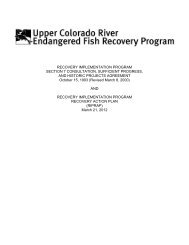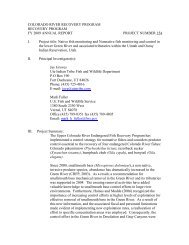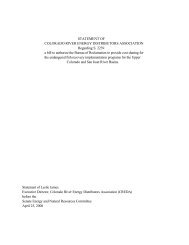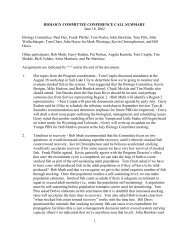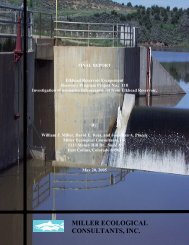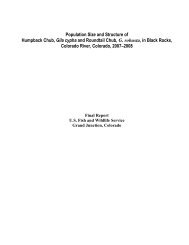K. R. Bestgen, K. A. Zelasko, and G. C. White. Monitoring ...
K. R. Bestgen, K. A. Zelasko, and G. C. White. Monitoring ...
K. R. Bestgen, K. A. Zelasko, and G. C. White. Monitoring ...
You also want an ePaper? Increase the reach of your titles
YUMPU automatically turns print PDFs into web optimized ePapers that Google loves.
using open population model (no assumption of demographic closure of populations) Cormack-<br />
Jolly-Seber estimation procedures. It is also possible to obtain estimates of annual transition<br />
rates of fish between sampling reaches if the sampling design supports a multi-state model<br />
analysis. Additional sampling between primary three-year sampling blocks sometimes allows<br />
for estimation of population rates of change (λ) that determine if population abundance (not<br />
estimated directly) is increasing, decreasing, or staying the same by essentially comparing<br />
survival <strong>and</strong> recruitment rates.<br />
Conveniently, population centers for razorback suckers in the Upper Colorado River<br />
Basin are mostly overlapped by sampling areas for Colorado pikeminnow. This is particularly<br />
true in the Green River Basin, because substantial captures of adult razorback suckers have<br />
occurred mainly in the mainstem Green River, with a few in the lower <strong>White</strong> River (e.g., 2011).<br />
Substantial numbers of razorback suckers do not occur in tributaries such as the San Rafael<br />
River, or the Green River upstream of the Yampa River, or the Yampa River itself, even though<br />
scattered individuals are occasionally found in those places. Instead, most captures have been in<br />
the mainstem Green River from downstream of Split Mountain boat ramp downstream to the<br />
confluence with the Colorado River. A similar situation exists in the Colorado River, where<br />
Colorado pikeminnow sampling areas broadly overlap with known distribution of stocked adult<br />
razorback suckers from just upstream of the confluence of the Gunnison <strong>and</strong> Colorado rivers<br />
downstream to the confluence with the Green River (<strong>Zelasko</strong> 2008; Osmundson <strong>and</strong> Seal 2009;<br />
<strong>Zelasko</strong> et al. 2010).<br />
Green River data, fish distribution, <strong>and</strong> macrohabitat use. —Because of broad overlap of<br />
sampling areas, monitoring population status of razorback suckers will borrow heavily from<br />
sampling for Colorado pikeminnow, since many razorback suckers are captured during that<br />
sampling (Table 2, captures by sampling program, 2006–2008 data). For example, of 1,177<br />
razorback sucker captures in the Green River Basin during 2006–2008, 1,079 (92%) were made<br />
during sampling for Colorado pikeminnow abundance estimation. Spring Colorado pikeminnow<br />
sampling is also conducted when razorback suckers may be most susceptible to capture, because<br />
they are in relatively shallow water near or at spawning areas.<br />
Additional razorback suckers were captured in the 2006–2008 period in the Green River<br />
during humpback chub Gila cypha sampling (n = 11), <strong>and</strong> northern pike Esox lucius <strong>and</strong><br />
smallmouth bass Micropterus dolomieu removal sampling (n = 16 <strong>and</strong> 71, respectively), but<br />
those contributions are small relative to captures during pikeminnow sampling; such additional<br />
26




